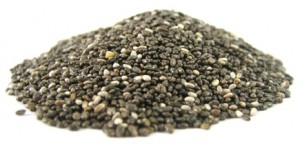I’m Experimenting: Ch-Ch-Ch-Chia Seeds

We’re going to start the week on a healthy note. Let’s take a little break from Thanksgiving prep to talk about a new adition to my diet, chia seeds. Have you heard of chia? You might remember Chia Pets, the cute little terracotta figurines you smear with seeds to help them grow “fur.” These are the same seeds, but don’t pilfer your pet’s stash – those seeds aren’t consumption grade. The ancient seeds are actually packed with rich nutrients. Chia seeds are a genus of the mint family, originating in Mexico’s central valley and were widely cultivated by Aztec cultures in pre-Hispanic times. Chia seeds were often used as currency for tax payments to nobility and as offerings for the Priesthood. They’re so nutritious that one tablespoon of seeds was believed to sustain an individual for 24 hours!
Chia is gluten-free, with very high concentrations of omega-3 fatty acids (ALA), significant levels of antioxidants, dietary fiber, oil, protein, calcium, phosphorous, and potassium. Two tablespoons of my Navitas Naturals chia powder have 70 calories, 4.5 grams of fat, 6 grams of fiber and 3 grams of protein.
So, why would a person choose chia over flax, another vegetarian source of omega-3′s? Chia actually has a slightly higher concentration of omega-3 fatty acids than flax. Another advantage of chia over flax is that chia is so rich in antioxidants that the seeds don’t deteriorate, so they can be stored for long periods without becoming rancid. And, unlike flax, chia doesn’t have to be ground to make its nutrients available to the body.
Another big reason to choose chia over flax is phytoestrogens. Are your eyes glazing over? Stick with me here! Those of you who’re living with breast cancer probably are already aware of phytoestrogens – they’re plant-based estrogens that may or may not mimic the natural estrogens in our body and therefore raise our estrogen levels. You can also find ‘em in soy, which is why a lot of women who’ve had breast cancer avoid or limit their soy consumption. Whether or not phytoestrogens raise your natural estrogen levels is still controversial, and I’ve heard differing opinions from reputable sources. So what’s the best alternative? Chia seed. Chia contains no phytoestrogens. And since it’s just as good, if not better source of ALA, why not use chia instead?
Another note – you can’t compare the omega-3 fatty acids in chia (or flax, for that matter) to the omega 3’s you get from salmon. It’s like comparing apples to oranges. The type of omega 3 in chia (and flax) is alpha-Linolenic acid, or ALA, which is different from the omega 3’s in fish – DHA and EPA – needed for optimal health. ALA must be converted in the body to DHA and EPA – so you need to eat seven times the amount of ALA to get 1 gram of DHA. That’s a helluva lot of chia. The bottom line here is that chia is a nutritious whole food and a good addition to a healthy diet. For a great all-around, but easy to understand primer on omega 3′s, take a look at this great post from Foodicate.
Whaddaya do with chia, anyway? Chia has a nutty, but unobtrusive flavor. You can mix the whole seeds in water and add lime or lemon juice and sugar to make a drink known in Mexico and Central America as “chia fresca.” As with ground flax, you can sprinkle ground or whole chia seeds on cereal, in yogurt or salads, or grind them and mix them with flour for making muffins or other baked goods. I’ve only tried them in smoothies, so far, and I will admit that I don’t foresee making baked goods with chia . . . I think that all the butter and sugar I use would negate any health benefit of the chia, frankly!
How ‘bout you? Have you tried chia? How do you incorporate these super-seeds into your diet?
© 2009, Sarah. All rights reserved.










